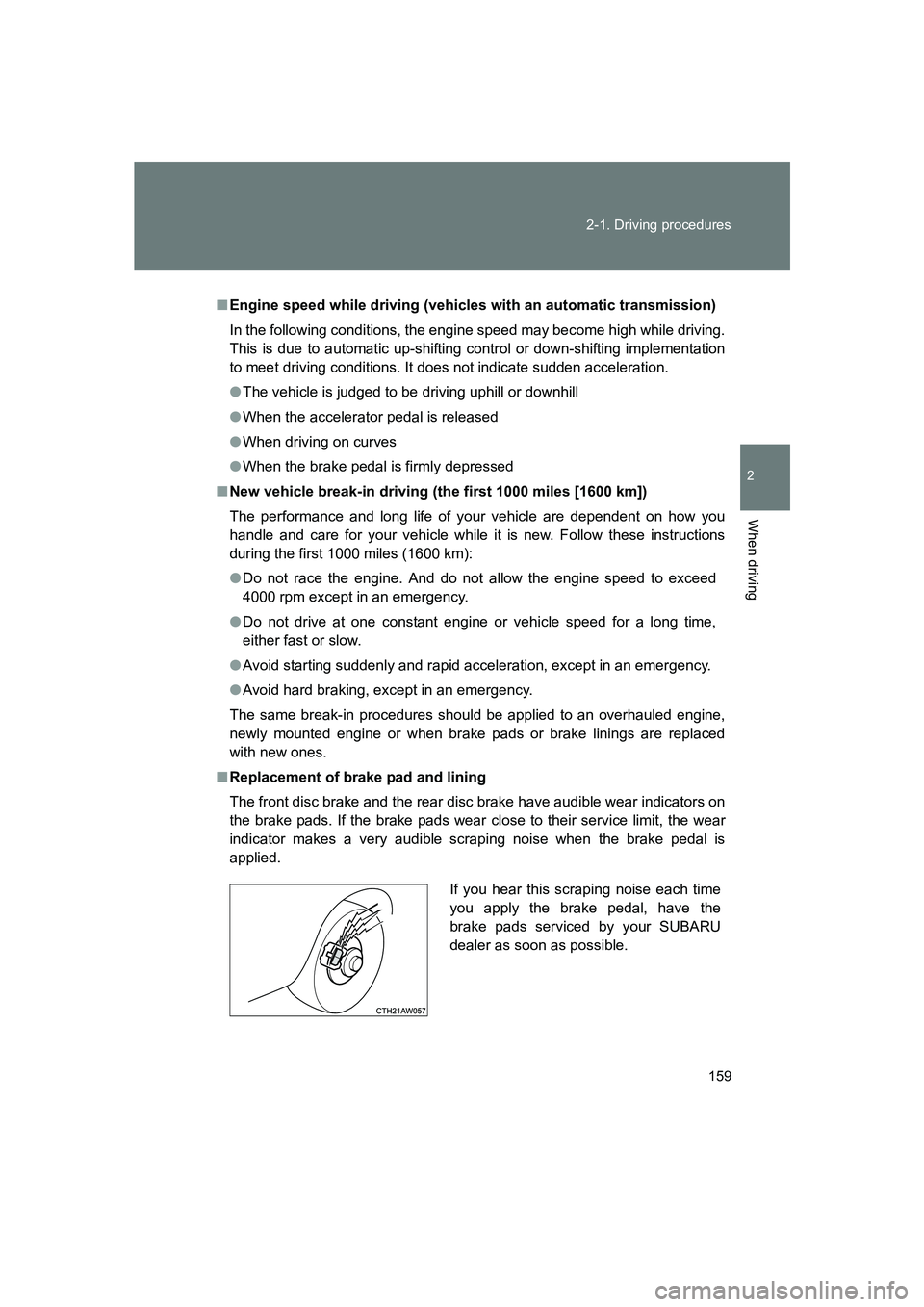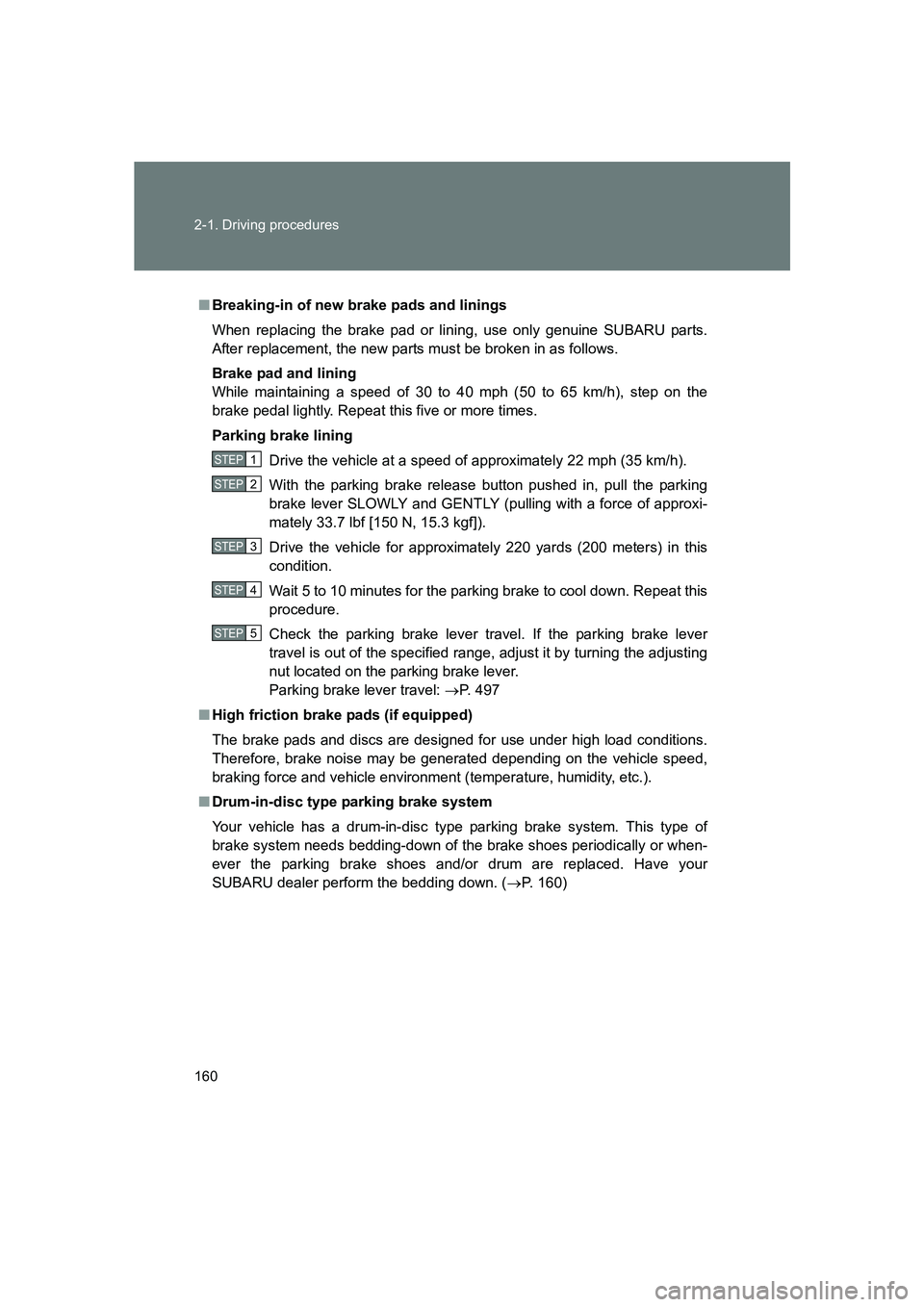Page 159 of 560

159
2-1. Driving procedures
2
When driving
BRZ_U
■
Engine speed while driving (vehicl es with an automatic transmission)
In the following conditions, the engine speed may become high while driving.
This is due to automatic up-shifting control or down-shifting implementation
to meet driving conditions. It does not indicate sudden acceleration.
● The vehicle is judged to be driving uphill or downhill
● When the accelerator pedal is released
● When driving on curves
● When the brake pedal is firmly depressed
■ New vehicle break-in driving (the first 1000 miles [1600 km])
The performance and long life of your vehicle are dependent on how you
handle and care for your vehicle while it is new. Follow these instructions
during the first 1000 miles (1600 km):
● Do not race the engine. And do not allow the engine speed to exceed
4000 rpm except in an emergency.
● Do not drive at one constant engine or vehicle speed for a long time,
either fast or slow.
● Avoid starting suddenly and rapid acceleration, except in an emergency.
● Avoid hard braking, except in an emergency.
The same break-in procedures should be applied to an overhauled engine,
newly mounted engine or when brake pads or brake linings are replaced
with new ones.
■ Replacement of brake pad and lining
The front disc brake and the rear disc brake have audible wear indicators on
the brake pads. If the brake pads wear close to their service limit, the wear
indicator makes a very audible scraping noise when the brake pedal is
applied.
If you hear this scraping noise each time
you apply the brake pedal, have the
brake pads serviced by your SUBARU
dealer as soon as possible.
Page 160 of 560

160 2-1. Driving procedures
BRZ_U
■Breaking-in of new brake pads and linings
When replacing the brake pad or lining, use only genuine SUBARU parts.
After replacement, the new parts must be broken in as follows.
Brake pad and lining
While maintaining a speed of 30 to 40 mph (50 to 65 km/h), step on the
brake pedal lightly. Repeat this five or more times.
Parking brake lining
Drive the vehicle at a speed of approximately 22 mph (35 km/h).
With the parking brake release button pushed in, pull the parking
brake lever SLOWLY and GENTLY (pulling with a force of approxi-
mately 33.7 lbf [150 N, 15.3 kgf]).
Drive the vehicle for approximately 220 yards (200 meters) in this
condition.
Wait 5 to 10 minutes for the parking brake to cool down. Repeat this
procedure.
Check the parking brake lever travel. If the parking brake lever
travel is out of the specified range, adjust it by turning the adjusting
nut located on the parking brake lever.
Parking brake lever travel: →P. 497
■ High friction brake pads (if equipped)
The brake pads and discs are desi gned for use under high load conditions.
Therefore, brake noise may be generated depending on the vehicle speed,
braking force and vehicle environment (temperature, humidity, etc.).
■ Drum-in-disc type parking brake system
Your vehicle has a drum-in-disc type parking brake system. This type of
brake system needs bedding-down of t he brake shoes periodically or when-
ever the parking brake shoes and/or drum are replaced. Have your
SUBARU dealer perform the bedding down. ( →P. 160)
STEP 1
STEP 2
STEP 3
STEP 4
STEP 5
Page 170 of 560

170 2-1. Driving procedures
BRZ_U
CAUTION
■Avoiding damage to vehicle parts
●Do not turn the steering wheel fully in either direction and hold it there for
an extended period of time.
Doing so may damage the power steering motor.
● When driving over bumps in the road, drive as slowly as possible to avoid
damaging the wheels, underside of the vehicle, etc.
● On vehicles with an automatic transmission, do not race the engine for
more than 5 seconds in any position except the N or P position when the
brake is applied or when chocks are used in the wheels. This may cause
the transmission fluid to overheat.
■ Replacement of brake pad and lining
If you continue to drive despite the scraping noise from the audible brake
pad wear indicator, it will result in the need for costly brake rotor repair or
replacement.
■ Breaking-in of new brake pads and linings
Pulling the parking brake lever too forcefully may cause the rear wheels to
lock. To avoid this, be certain to pull the lever up slowly and gently.
■ If you get a flat tire while driving
A flat or damaged tire may cause the following situations. Hold the steering
wheel firmly and gradually depress the brake pedal to slow down the vehicle.
●It may be difficult to control your vehicle.
● The vehicle will make abnormal sounds or vibrations.
● The vehicle will lean abnormally.
Information on what to do in case of a flat tire ( →P. 453)